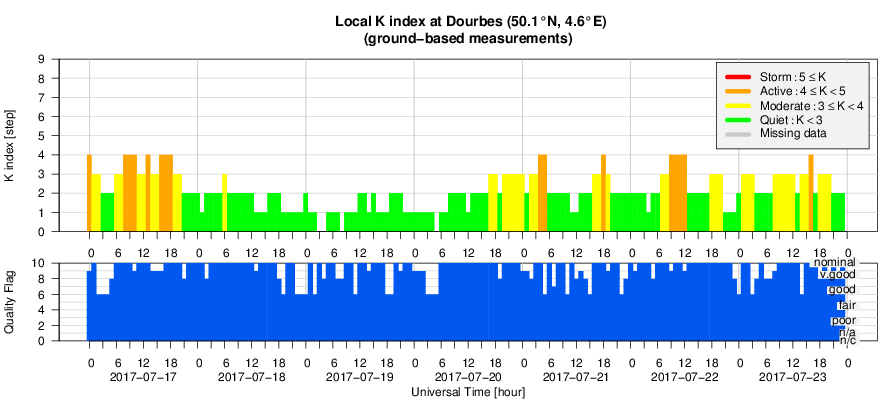- Table of Content
- 1.NOAA 2665's fi...
- 2.Review of sola...
- 3.PROBA2 Observa...
- 4.The Internatio...
- 5.Review of geom...
- 6.Geomagnetic Ob...
- 7.Review of iono...
- 8.Future Events
2. Review of solar activity
3. PROBA2 Observations (17 Jul 2017 - 23 Jul 2017)
4. The International Sunspot Number
5. Review of geomagnetic activity
6. Geomagnetic Observations at Dourbes (17 Jul 2017 - 23 Jul 2017)
7. Review of ionospheric activity (17 Jul 2017 - 23 Jul 2017)
8. Future Events
NOAA 2665's fireworks continues!
Early on 18 July, NOAA 2665 rounded the west limb. It had already produced a strong eruption on 14 July (see the news item at http://www.stce.be/news/393/welcome.html ), but continued its activity with complex eruptions late on 17 July and a spectacular one on 20 July. Nonetheless, the cherry on the pie was the 23 July farside eruption, which reminded many of the Carrington-like event that took place exactly 5 years ago, also on the Sun’s farside (see http://www.stce.be/news/152/welcome.html for more info on this eruption).
At the time of the 23 July event, NOAA 2665 was located about 61 degrees behind the west limb as seen from Earth, so the eruption did not trigger a GOES x-ray flare. The sketch underneath to the left shows the positions of Earth (green), STEREO-A (red) and Mars (grey) with respect to the Sun (yellow) as seen from above. To the right, and also seen from above the Sun, half arcs indicate which part of the Sun can be seen from these 3 vantage points (same color code). The blue dots indicate the position of NOAA 2665 at each of its eruptions on 14, 17, 20 and 23 July. While completely invisible from Earth, the 23 July event took place at the east limb as seen from STEREO-A, and well on the eastern solar hemisphere as seen from Mars. Gif-movies and links to references can be found in the online version of this news item at http://www.stce.be/news/394/welcome.html
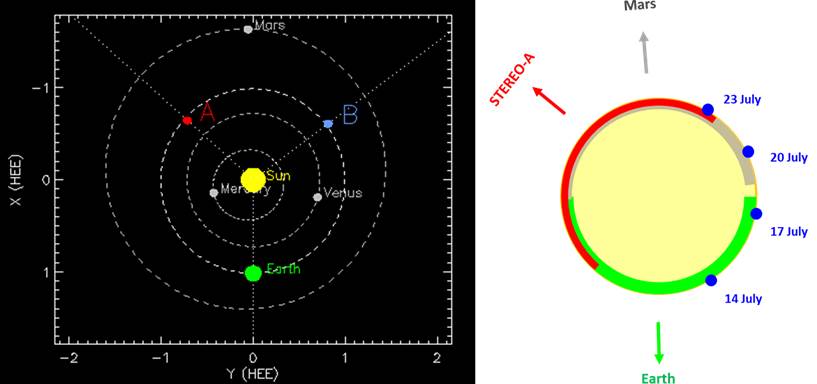
The 2012 eruption originated in NOAA 1520, one of the largest sunspot regions of solar cycle 24 (SC24). As can be seen in the table underneath, it reached a maximum sunspot area twice that of NOAA 2665, or the equivalent of about 8 times the Earth's surface (see this news item at http://www.stce.be/news/280/welcome.html for more info on sunspot areas). At the time of the eruption, it was not as far over the west limb as NOAA 2665 in 2017 (43 degrees vs. 61 degrees). However, for STEREO-A, which has been rounding the Sun's farside over the last few years, it made a big deal. Indeed, the 2012 eruption was located close to the central meridian (12 degrees west), whereas during the 2017 event, the active region had barely rounded the east limb (78 degrees east).
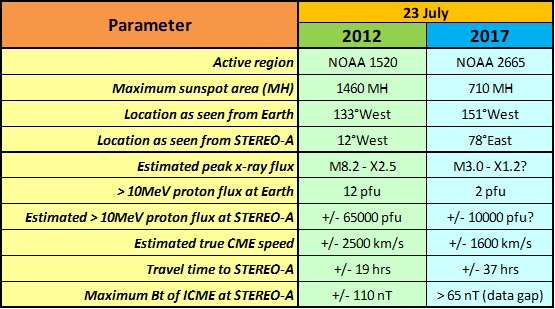
Due to their position on the Sun's farside, both 23 July flares could not be recorded by the GOES spacecraft. However, some ingenious use of STEREO-A's EUV (extreme ultraviolet) imagery and data allows to deduce a likely range for the peak of the x-ray flare (Nitta et al. 2013 ; Chertok et al. 2015). For the 2012 blast, this peak would most likely have been between M8.2 and X2.5. The 2017 flare seems to have been somewhat less intense, between M3.0 and X1.2. Hence, a low-level X-class event cannot be excluded. Testifying for the strength of this eruption were the strong coronal dimming, the obvious coronal wave, and the series of bright post-flare coronal loops ("arcade"). See STEREO-A's EUV imagery underneath (EUVI 195; https://stereo-ssc.nascom.nasa.gov/ ).
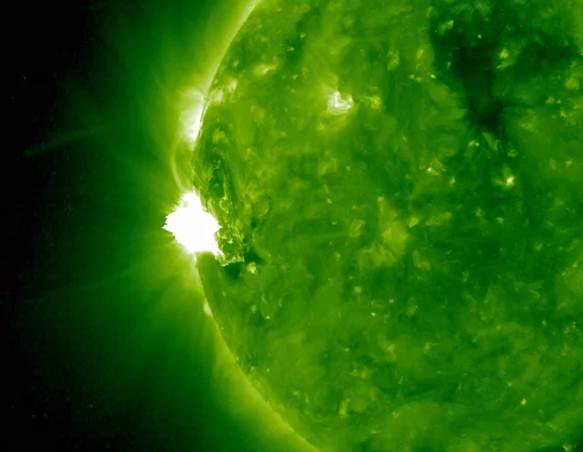
STEREO-A also observed a strong increase in the number of protons with energies greater than 10 MeV (see news item at http://www.stce.be/news/233/welcome.html for more details on the intensity and units for proton events), despite being on the "wrong" side of the eruption and thus not well connected to the source region. This is in contrast to the 2012 event, where conditions were almost ideal for a strong proton event. It was calculated that GOES would have measured a severe energetic storm particle (ESP) event of about 65.000 pfu in 2012 (Gopalswamy et al. 2014 ; Gopalswamy et al. 2016). Looking at the relevant particle graph (red curve) as recorded by STEREO-A, it becomes clear that the 2017 ESP event was not as intense, and a crudely estimated peak value of about 10.000 pfu seems even optimistic. The much weaker 2017 proton event is emphasized by the fact that STEREO-A's EUV imagery was barely affected by the proton impacts (see image comparison underneath, at the time of the peak). Also, the proton flux observed at Earth was only enhanced to 2 pfu, whereas in 2012 it reached 12 pfu and thus became a genuine proton event (>10 pfu), despite the source region being so far beyond the west limb!
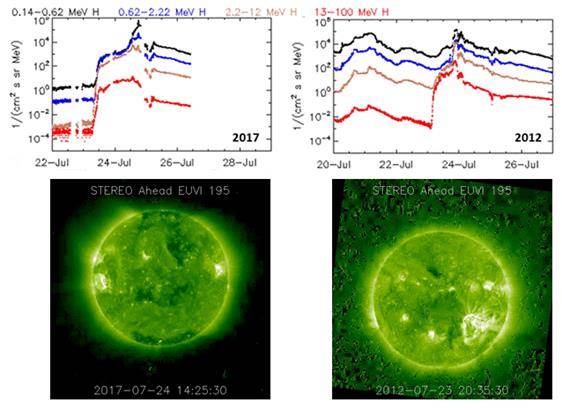
The coronal mass ejection (CME) associated with this eruption was a halo CME as observed from STEREO-A, Mars and Earth. Obviously, the CME was directed away from Earth. The speed of the CME was calculated to be around 1600 km/s, and it arrived at STEREO-A about 37 hours later. These are no extraordinary figures, in contrast to the 2012 CME which reached an estimated speed of 2500 km/s (Baker 2016), making this a "rare" event on the SCORE-scale (Evans et al. 2013). The plasma cloud passed the STEREO-A spacecraft only 19 hours later making this a very rare Fast Transit Event (FTE), truly comparable to the Carrington event in 1859. The intensity of the magnetic field (Bt) of the interplanetary CME reached 110 nT in the 2012 event, and was at least 65 nT in 2017, but a data gap prevents a more accurate assessment. Mars is expected to be closer to the bulk of the CME, with a most likely impact predicted for 26-27 July.
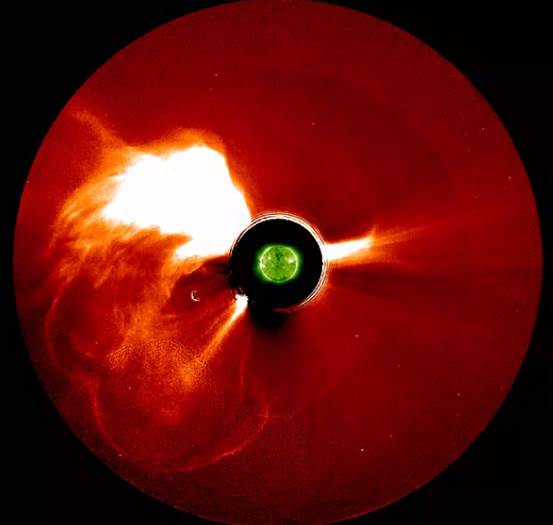
The above findings indicate that the 23 July 2017 event was a strong one so deep in SC24, but at the same time they also suggest that it was a lot more modest than the 2012 eruption on all three counts: flare strength, proton flux and the CME speed and intensity. There's no doubt that the NOAA 2665's complex and spectacular eruptions from 14, 17, 20 and 23 July will be extensively researched in years to come.
Review of solar activity
There was only a single spotted region on disk during the week. NOAA active region 2665 produced several low-level C-class flares as it was approaching and rounding the West limb early on 18 July (SDO image underneath). By early on 20 July, the region was far enough on the Sun's farside for GOES to not detect any significant flaring anymore from this region. From then on till the end of the period, solar activity was very low with no more C-class flaring observed.
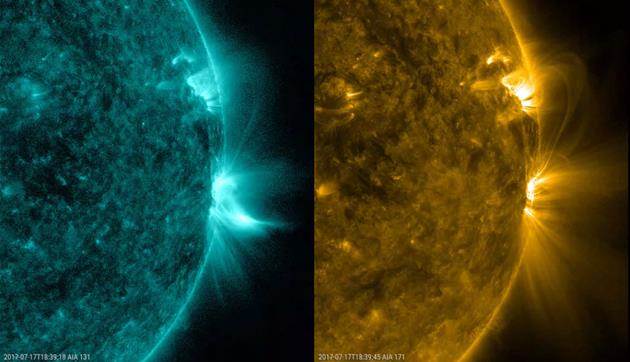
A number of coronal mass ejections (CMEs) were associated with region 2665. Those observed while it was on disk were insignificant, e.g. the CME associated with the 17 July flare (image underneath) . But it also produced a partial halo limb CME on 20 July and later a full halo CME on 23 July while at the farside of the Sun. None were Earth effective.
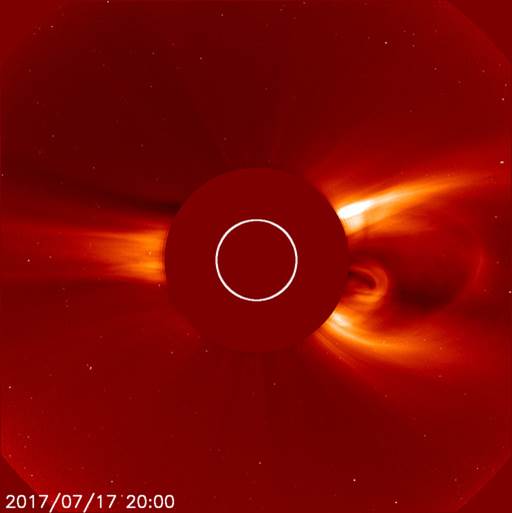
Proton flux levels remained at background values throughout the week.
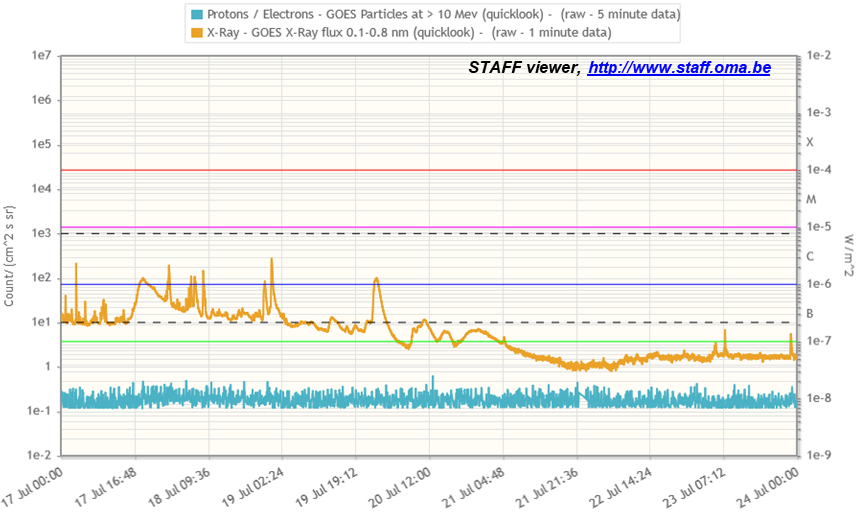
PROBA2 Observations (17 Jul 2017 - 23 Jul 2017)
Solar Activity
Solar flare activity fluctuated between very low and low during the week.
In order to view the activity of this week in more detail, we suggest to go to the following website from which all the daily (normal and difference) movies can be accessed: http://proba2.oma.be/ssa
This page also lists the recorded flaring events.
A weekly overview movie can be found here (SWAP week 382).
http://proba2.oma.be/swap/data/mpg/movies/weekly_movies/weekly_movie_2017_07_17.mp4
Details about some of this week’s events, can be found further below.
If any of the linked movies are unavailable they can be found in the P2SC movie repository here
http://proba2.oma.be/swap/data/mpg/movies/
Monday Jul 17
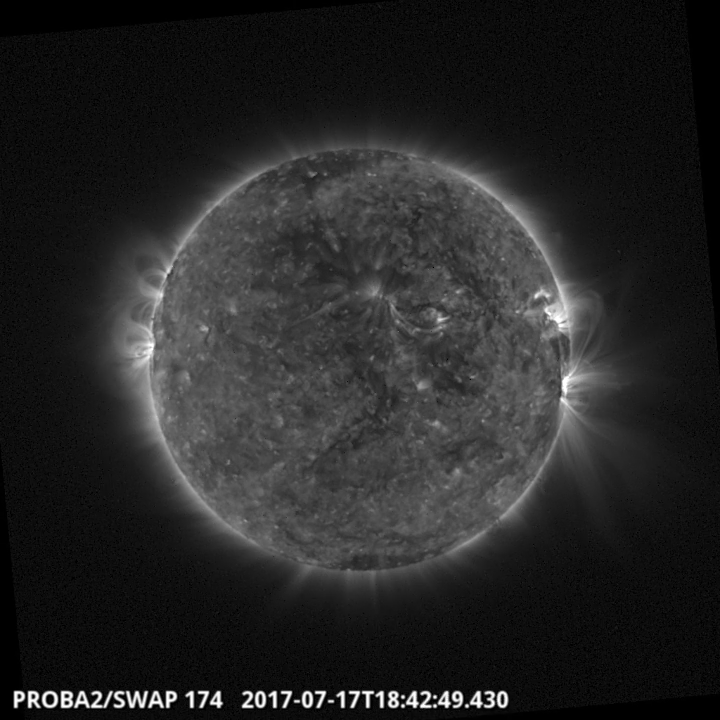
A long duration C1.2 flare was observed on 2017-Jul-17, starting at 17:09 UT and ending at 20:50 UT produced by the NOAA active region 2665, and is visible on the west limb of the Sun in the SWAP image above. It was associated small width CME.
Find a movie of the events here (SWAP movie)
http://proba2.oma.be/swap/data/mpg/movies/20170717_swap_movie.mp4
Tuesday Jul 18
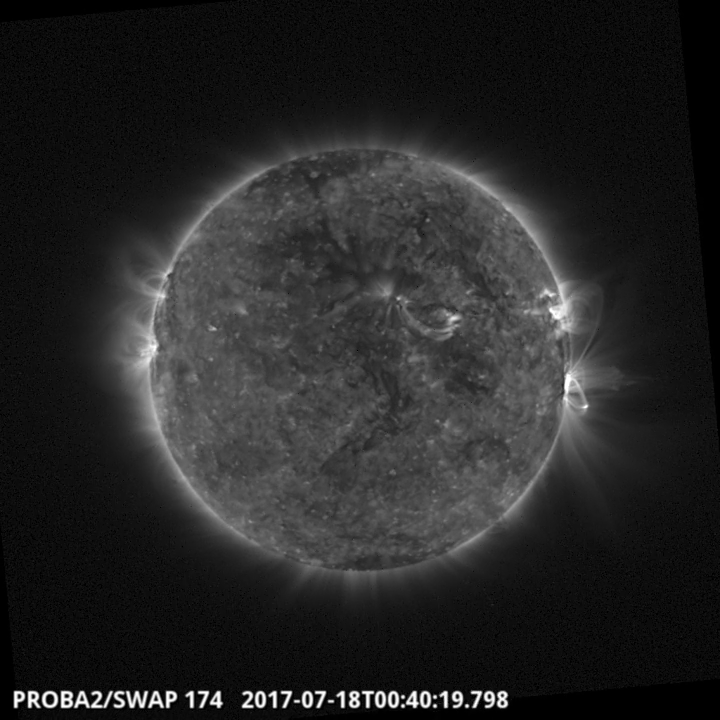
A C2.0 class flare was produced by AR 2668, peaking at 00:40 UT on 2017-Jul-18, which was visible on the west limb of the Sun. This can be seen in the of the SWAP image above.
Find a movie of the events here (SWAP movie)
http://proba2.oma.be/swap/data/mpg/movies/20170718_swap_movie.mp4
The International Sunspot Number
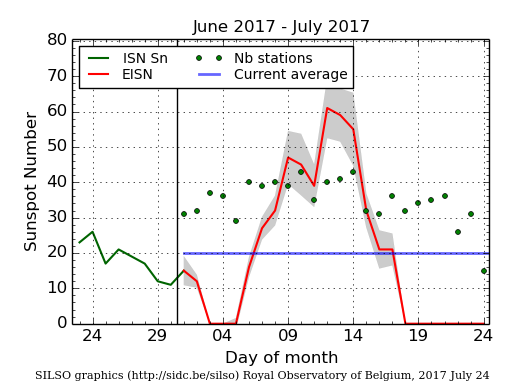
The daily Estimated International Sunspot Number (EISN, red curve with shaded error) derived by a simplified method from real-time data from the worldwide SILSO network. It extends the official Sunspot Number from the full processing of the preceding month (green line). The plot shows the last 30 days (about one solar rotation). The horizontal blue line shows the current monthly average, while the green dots give the number of stations included in the calculation of the EISN for each day.
Review of geomagnetic activity
At the start of the week, solar wind was recovering from the impact of the 14 July CME. With some periods of strongly southward Bz (down to -15 nT), up to moderate geomagnetic storm levels (Kp = 6) were recorded. Later in the week we saw the impact of the northern polar coronal hole extension with an associated high speed stream reaching speeds of close to 750 km/s. Some isolated active geomagnetic conditions were reported as a consequence, with a single minor storming episode (Kp = 5) on 22 July.
A plot with last week's solar wind data as recorded by DSCOVR can be found underneath. It shows respectively the magnetic field strength (white and red curve) and its direction towards or away from the Sun (blue), the density (orange), the speed (yellow) and the temperature (green). The particle data show some instrumental noise on 18 and 21 July.
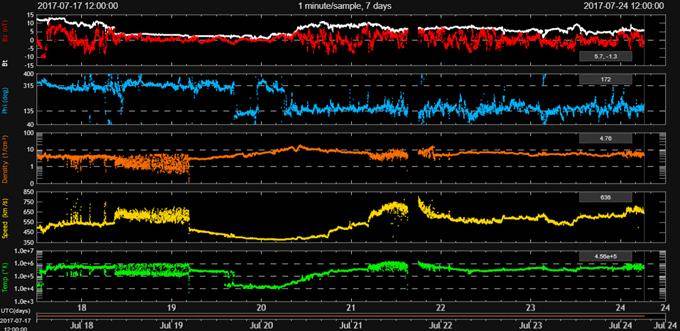
Review of ionospheric activity (17 Jul 2017 - 23 Jul 2017)
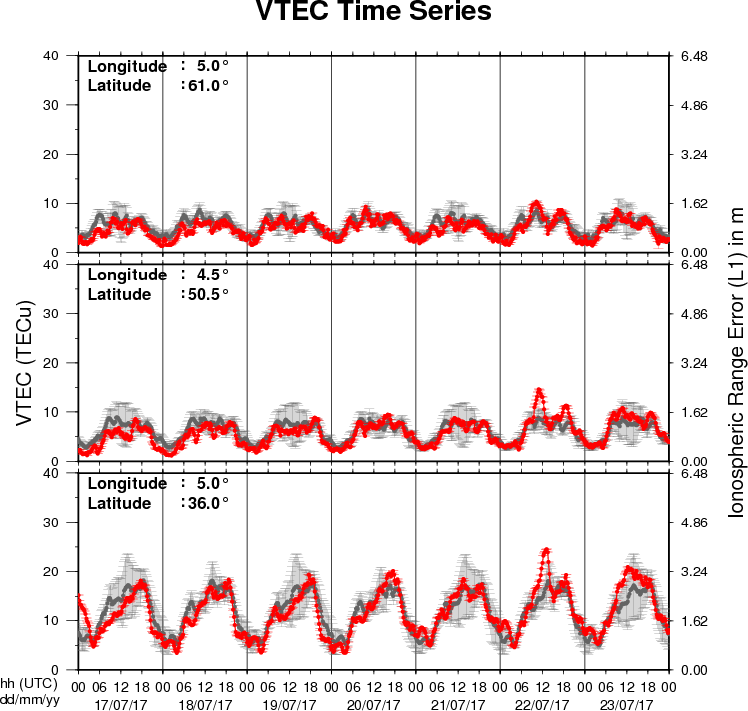
The figure shows the time evolution of the Vertical Total Electron Content (VTEC) (in red) during the last week at three locations:
a) in the northern part of Europe(N61°, 5°E)
b) above Brussels(N50.5°, 4.5°E)
c) in the southern part of Europe(N36°, 5°E)
This figure also shows (in grey) the normal ionospheric behaviour expected based on the median VTEC from the 15 previous days.
The VTEC is expressed in TECu (with TECu=10^16 electrons per square meter) and is directly related to the signal propagation delay due to the ionosphere (in figure: delay on GPS L1 frequency).
The Sun's radiation ionizes the Earth's upper atmosphere, the ionosphere, located from about 60km to 1000km above the Earth's surface.The ionization process in the ionosphere produces ions and free electrons. These electrons perturb the propagation of the GNSS (Global Navigation Satellite System) signals by inducing a so-called ionospheric delay.
See http://stce.be/newsletter/GNSS_final.pdf for some more explanations ; for detailed information, see http://gnss.be/ionosphere_tutorial.php
Future Events
For more details, see http://www.spaceweather.eu/en/event/future
United Nations/United States of America Workshop on the International Space Weather Initiative in Massachusetts (USA)
Start : 2017-07-31 - End : 2017-08-04
This workshop marks the 10th anniversary of the International
Heliophysical Year, which led to the genesis of the International
Space Weather Initiative. It is organized jointly by the Office for
Outer Space Affairs, the National Aeronautics and Space
Administration (NASA) and Boston College to highlight the
achievements made over the past ten years and to show-case the
worldwide development of science, capacity building, and
outreach.
The UN Workshops on ISWI have been aimed at providing a global
forum for space weather experts from developed and developing
countries, including representatives of the major instrument
operators and data providers. In particular the Workshop will focus
on recent advances made in scientific research by utilizing ISWI
instrument data in conjunction with space mission data in adding
significant new knowledge on space weather phenomena near Earth and
interplanetary space.
The workshop will begin with a high level international forum on
the economic and societal effects of extreme space weather. This
forum will include keynote speakers from major international
organizations followed by a panel session to discuss issues and
policies for acknowledging space weather as a global challenge.
The workshop is also held in preparation for UNISPACE+50 in
2018, the 50th anniversary of the first UN Conference on the
Exploration and Peaceful Uses of Outer Space (UNISPACE), held in
Vienna in 1968. The three components of the Workshop will also help
develop a coherent international policy towards an appropriate
response to space weather.
Website: https://iswi2017.bc.edu/
URSI General Assembly in Montreal, Canada
Start : 2017-08-19 - End : 2017-08-26
For the thirty-second time since the inception of URSI, Radio
Scientists from across the world will get together for the URSI
General Assembly and Scientific Symposium. This triennial gathering
will take place from 19th to 26th of August 2017, in Montreal,
Canada. This conference is a unique opportunity to learn about
recent advances in all fields of Radio Science, as covered by all
ten URSI Commissions.
Among the different sessions, please note:
* 'Radio Science for Space Weather'
Conveners: M. Messerotti, V. Pierrard
* 'Remote Sensing and Modeling of the Earth's Plasmasphere
and Plasmapause'
Conveners: A. M. Jorgensen, V. Pierrard, B. Heilig
The abstract deadline is 30 January 2017
Website: http://www.ursi2017.org
2017 Joint IAPSO-IAMAS-IAGA Assembly in Cape Town, South Africa
Start : 2017-08-27 - End : 2017-09-01
The Joint IAPSO-IAMAS-IAGA Assembly, endorsed by the University
of Cape Town and the South African Department of Science and
Technology, will take place from 27 August to 1 September 2017 at
the Cape Town International Convention Centre (CTICC). Several IAGA
and IAMAS sessions are of Space Weather interests as well as the
joint session 'Space Weather throughout the Solar System: Bringing
Data and Models together'.
Website:
http://iapso-iamas-iaga2017.com/index.php
Workshops on Radiation Monitoring for the International Space Station in Torino, Italy
Start : 2017-09-05 - End : 2017-09-07
The Workshop on Radiation Monitoring for the International Space
Station is an annual meeting to discuss the scientific definition
of an adequate radiation monitoring package and its use by the
scientific community on the ISS. Types of instruments and research
topics need to be defined in order to optimise the radiation safety
of the ISS crew.
Website: http://wrmiss.org/
International Workshop on Solar, Heliospheric & Magnetospheric Radioastronomy in Meudon, France
Start : 2017-11-06 - End : 2017-11-10
Jean-Louis Steinbeg has been one of the major pioneers in
radioastronomy. Co-founder of the Nançay Observatory, he
has actively participated to, an inspired a large number of radio
instruments on many international space missions. Jean-Louis
Steinberg is the founder of the Space Radioastronomy laboratory of
the Paris Observatory in 1963. Later on, this laboratory widened
its science interests and became the DESPA (1971) and then the
current LESIA (2002) which is one of the major space sciences
laboratories in France. The aim of this workshop is to cover the
science topics which Jean-Louis Steinberg has promoted during his
career, focusing on Solar, Heliospheric & Magnetospheric
radioastronomy & physics. This will be done by covering both
observations from either ground facilities (NDA, RH, LOFAR, Artemis
etc ...) or space missions (ISSEE, Ulysses, WIND, CLUSTER, STEREO,
CASSINI, JUNO etc ...) and models/theories. A series of invited
talks is also foreseen to cover the new developments in the
discipline which may come with the future facilities such as Solar
Orbiter, Solar Probe Plus, JUICE, JUNO, LOFAR+, SKA etc ....
This workshop will also be the opportunity to remember both the
extraordinary personal & professional lifes of Jean-Louis
Steinberg especially for new generation of scientists. At the
occasion of this workshop it is also expected that the Building 16
(historical Space Sciences building) on the Meudon campus will be
renamed "Building Jean-Louis Steinberg".
Website:
https://jlsworkshop.sciencesconf.org/
European Space Weather Week 14
Start : 2017-11-27 - End : 2017-12-01
The ESWW is the main annual event in the European Space Weather
calendar. It is the European forum for Space Weather as proven by
the high attendance to the past editions. The agenda will be
composed of plenary/parallel sessions, working meetings and
dedicated events for service end-users. The ESWW will again adopt
the central aim of bringing together the diverse groups in Europe
working on different aspects of Space Weather.
Website:
http://www.stce.be/esww14/
